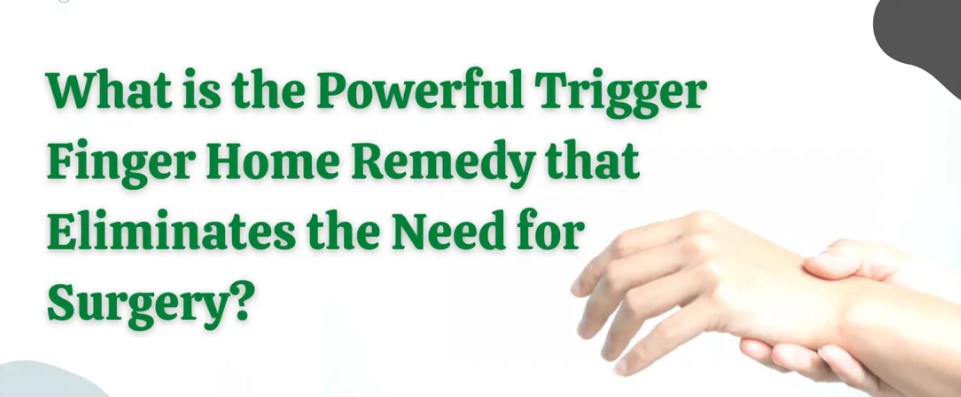Trigger finger is a condition that affects the tendons in your fingers or thumb, causing them to catch or lock when you try to straighten or bend them. It can be a painful and frustrating condition, but the good news is that there are non-surgical treatment options available. In this article, we will explore the causes of trigger finger and discuss effective non-surgical treatment for trigger finger causes.
Introduction:
When your finger or thumb gets stuck in a bent position and then pops back into place, it may be a sign of trigger finger. This condition occurs when the tendons in your fingers become inflamed or irritated. While surgery is an option for severe cases, non-surgical treatments can often provide relief and improve mobility without the need for invasive procedures.
Understanding Trigger Finger
Trigger finger, also known as stenosing tenosynovitis, is a condition that affects the flexor tendons in your fingers or thumb. These tendons help control the movement of your fingers by connecting the muscles in your forearm to the bones in your fingers. When the flexor tendons become irritated or inflamed, they can thicken and develop nodules, making it difficult for them to slide smoothly through the tendon sheath.
Causes of Trigger Finger
The exact cause of trigger finger is often unknown, but certain factors can increase the risk of developing this condition. Some common causes include:
- Repetitive Hand Movements: Engaging in activities that involve repetitive gripping or grasping motions can strain the tendons in your fingers, leading to trigger finger.
- Medical Conditions: Trigger finger is more common in individuals who have certain medical conditions such as diabetes, rheumatoid arthritis, or hypothyroidism.
- Age and Gender: Trigger finger tends to be more prevalent in individuals over the age of 40, and women are more likely to develop this condition than men.
Non-Surgical Treatment Options
Fortunately, there are several non-surgical treatments for trigger finger causes. These treatments aim to reduce inflammation, relieve pain, and improve finger mobility. Here are some effective non-surgical treatments:
Rest and Activity Modification
Resting the affected finger or thumb and avoiding activities that worsen the symptoms can help alleviate discomfort and promote healing. Modifying your activities to minimize repetitive hand movements is crucial during the recovery process.
Finger Exercises and Stretches
Performing gentle exercises and stretches can help improve the flexibility and range of motion in your fingers. Simple exercises like finger bends, finger taps, and finger spreads can be beneficial in relieving stiffness and reducing the locking or catching sensation.
Splinting
Wearing a splint or brace can provide support and immobilize the affected finger, allowing the inflamed tendons to rest and heal. Splinting is often recommended during sleep or when engaging in activities that may exacerbate the symptoms.
Medications
Over-the-counter nonsteroidal anti-inflammatory drugs (NSAIDs) like ibuprofen can help reduce pain and inflammation associated with trigger finger. However, it is essential to consult with a healthcare professional before taking any medication to ensure it is suitable for you.
Corticosteroid Injections
Corticosteroid injections are a common non-surgical treatment option for trigger finger. The injection delivers a powerful anti-inflammatory medication directly into the tendon sheath, reducing inflammation and relieving symptoms. Multiple injections may be required for optimal results.
Physical Therapy
Physical therapy sessions with a qualified therapist can be beneficial for trigger finger. The therapist will guide you through exercises and techniques to improve finger mobility and strength. They may also use modalities such as ultrasound or heat therapy to alleviate pain and inflammation.
Alternative Therapies
Certain alternative therapies, such as acupuncture or hand therapy, may offer relief for trigger finger symptoms. While the effectiveness of these therapies may vary from person to person, they can be worth considering as part of a comprehensive treatment plan.
Lifestyle Changes for Trigger Finger Prevention
In addition to non-surgical treatments, making certain lifestyle changes can help prevent trigger finger from recurring or worsening. Some recommendations include:
- Taking regular breaks during repetitive hand activities to avoid overuse.
- Maintaining a healthy weight to reduce strain on the finger joints and tendons.
- Practicing hand exercises and stretches regularly to keep the fingers flexible and strong.
- Using ergonomic tools or modifying the grip to minimize stress on the fingers during daily tasks.
Conclusion
Non-surgical treatments offer a promising solution for individuals with trigger finger, providing relief from pain and restoring finger mobility. By following a comprehensive treatment plan that includes rest, exercises, splinting, and other therapies, you can effectively manage trigger finger without resorting to surgery. Remember to consult with a healthcare professional to determine the best course of treatment for your specific condition.
FAQs
- Can trigger finger be cured without surgery?
- Yes, many cases of trigger finger can be successfully treated without surgery using non-surgical methods such as rest, splinting, exercises, and corticosteroid injections.
- How long does it take for non-surgical treatments to work for trigger finger?
- The effectiveness of non-surgical treatments can vary depending on the severity of the condition. Some individuals may experience relief within a few weeks, while others may require several months of treatment.
- Are there any home remedies for relieving trigger finger symptoms?
- While non-surgical treatments are typically recommended, some home remedies such as applying ice packs, performing gentle massages, and practicing good hand hygiene can help alleviate symptoms.
- Can trigger finger come back after treatment?
- In some cases, trigger finger may recur even after non-surgical treatment. Following preventive measures, such as lifestyle modifications and regular hand exercises, can help reduce the chances of recurrence.
- Is trigger finger a sign of arthritis?
- While trigger finger is more common in individuals with arthritis, it is not always a direct sign of arthritis. However, if you have arthritis, you may be more susceptible to developing trigger finger.


No comments yet